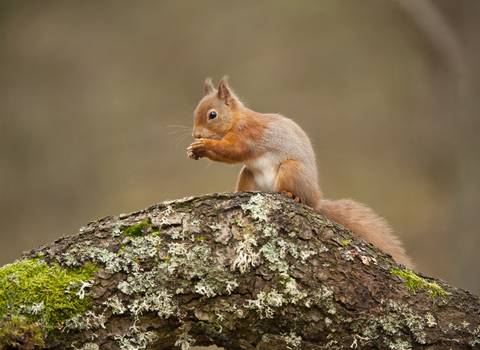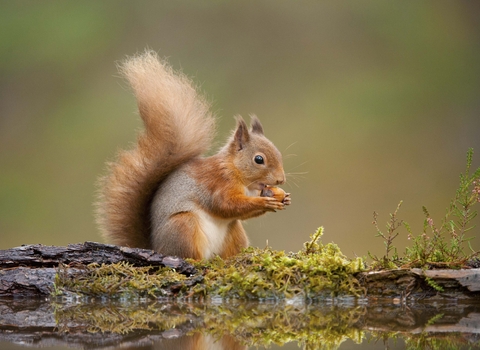Do red and grey squirrel habitats differ?
Red squirrels and grey squirrels can often show an overlap in their choice of habitat, and in forests where both species are present numbers of red squirrels tend to decline rapidly as they are out-competed by the grey squirrels. This very often leads to a complete loss of red squirrels in that region. However, there are some important differences in the type of tree used by each species.
Grey squirrels tend to rely on trees with large seeds that have high calorific values, such as oaks, whereas red squirrels can feed on smaller seeds with lower calorific values, such as the seeds of coniferous trees like pines or broad-leaved trees like alder. This is the reason that most UK red squirrel populations are restricted to coniferous woodlands, where grey squirrels have struggled to get a foothold.
Managing woodland for red squirrels
In the regions where red squirrels can still be found but grey squirrels are absent, careful management of the woodland habitat can help red squirrels to survive. The management plans revolve around two key principles: making the habitat as attractive as possible for red squirrels, and as ‘unattractive’ as possible to grey squirrels.
Making an attractive habitat for red squirrels
There are several options available to make a woodland more attractive to red squirrels, but it really comes down to ensuring there is a healthy food supply available all year round. Red squirrels primarily feed on seeds and nuts, supplementing their diet with fruit, plant shoots and fungi when their preferred food is less readily available. However, conifers don’t always produce seeds every year, and many species will not start producing seeds until they reach a certain age – up to 20 years old for some trees.
To make sure there are always seeds available for red squirrels, woodland can be managed to ensure there is a healthy variety in the age of the trees present, as well as providing a variety of tree species on which the red squirrels can feed. They prefer conifers with large seeds, such as larch and Norway spruce, but it is a balancing act between providing red squirrels with their ideal food choice and not attracting grey squirrels into the area.
The location and timing of any forestry work is also important in optimising woodland management for red squirrels, such as avoiding any felling whilst young squirrels are still present in their nests (known as a drey). Also, as red squirrels like to have a continuous canopy to move through, ensuring that solid corridors remain between seeding trees can help keep a woodland attractive to them.
Making a habitat unattractive to grey squirrels
The second habitat management principle, making forests unattractive to grey squirrels, relies on producing ‘islands’ of woodland that can only support red squirrels, with some form of barrier between that forest and any surrounding ‘grey squirrel friendly’ areas. These barriers can include coniferous trees, arable land or moorland, and are designed to discourage grey squirrels from entering the red squirrel habitat, where they would be likely to have a negative impact on the red squirrels.
The habitat management techniques described here can help towards maintaining surviving populations of red squirrels, but it is a fragile balance as it only takes a very small number of broad-leafed trees to allow grey squirrels to survive within a coniferous forest. For this reason habitat management is used alongside other forms of conservation management including control of grey squirrels in carefully chosen areas to help remaining populations of red squirrels to survive.


